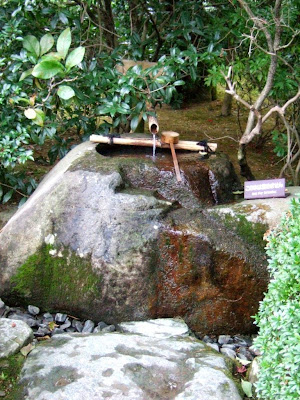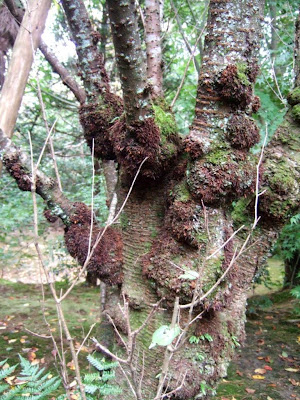
It was said that the site of Ryoan-ji Temple was originally an aristocrat's villa building on an estate belonging to Fujiwara clan during Heian period. The Temple was first established with a pond by Fujiwara Saneyoshi using the name as Daiju-in. In year 1450, warlord Hosokawa Katsumoto (1430-73) acquired the land where Daiju-in stood and converted it into a temple complex. Ryoan-ji built by Katsumoto was destroyed in Onin war (1467-77) but restored in year 1488 by his son Matsumoto. The 7-imperial group tombs at temple site are the mausoleum for late Hosokawa Emperors. Ryoan-ji Temple is world famous for its Karesansen Zen Garden especially after the visit of Queen Elizabeth in 1975.


In 1779, Ryoan-ji Temple suffered another fire. The present complex was rebuilt on the rubble of building in year 1799.


I was surprised to find a seated image of Buddha Amitabha , not sheltered, at the wooded garden of Temple grounds.



At the back of building structures, there are couple of smaller gardens.





Hojo is the former residence of temple head priest. It features some Fusuma paintings on the sliding panels of its tatami rooms. Its veranda offers the best seat for one to mindfully gaze into the rocks in the Zen Garden to seek for some hidden meanings. The two characters were the name of a Chinese historical great general who had been worship as a Dharma protector in Mahayana Buddhism.



Karesansen Zen Rock Garden in Ryoan-ji Temple is one of the most famous in Kyoto. When was this Soami styled garden first laid out, was uncertain but it was believed to date from 12th century. The 15 rocks on patches of moss were laid out on a 25x10 meters rectangular plot of raked gravel winded up by low earthen walls. The interesting thing is that no one is able to have all the 15 rocks captured under a view as from whichever vintage angle, there is always one rock missing from the view.


I did not know whether the arrangement of rocks represents tiger carrying cubs crossing water pond as what the common theme of Japanese rock garden used to be , or just the islands in a sea, but I guessed its setting and pattern should be in favor of Zen meditation.


Arrangement of distinctive larger rock formations setting amidst a smooth pebbles that are raked into patterns, are the normal design of Japanese Zen dry landscaped garden. The Model of Karesansen Rock Garden shows clearly that the 15 rocks of Ryoan-ji were arranged with a setting of 1x5 stones + 2x3 stones and 2x2 stones.


Tea garden is considered as one of the most sublime and value cultural treasure that the temple offers as it teaches us Dharma in silence.


The stone trough Tsukubai with water non-stopped flowing up for ritual purification at Tea Garden site is the most interesting and meaningful artifact. It was said to be contributed by Tokugawa Mitsukumi in 17th century. The trough was placed at a lower height so that any one who wish to purify has to bend down and lower himself. This was a signal to show reverences and reduce self-ego. The round stone basin has a square opening like a sign of Chinese character mouth 口 inscribed with 4 simple Kanji characters 五。佳。足。矢。 The 4 kanji after adding in 口 contains a profound meaning as it becomes 吾唯足知 which means I learn only to be contented.



Moss garden


The well trimmed and maintained pine trees in the moss garden are impressive.



Kyoyochi Pond was believed to be established in 12th century, at the time when the temple site was a villa.




Spacious park with huge area of water pond created a scenic and serene sight






Shrine on the little island in the pond is accessible from stone bridge





It was so peaceful and relaxing when leisurely strolling on the walking trail along the pond under a calm circumstance with nature.



Just imagine, how attractive would be the sight in summer when the lily fully blossom in the pond.



















































No comments:
Post a Comment